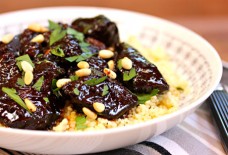Burghul: The Noblest Achievement of Wheat
By: Habeeb Salloum/Contributing Writer
The hot Saskatchewan July wind made us uncomfortable as my brother and myself went searching for wood scraps in the surrounding treeless prairie land.This was an important yearly task for us children in the age-old method of producing our yearly supply of burghul. We had to find enough wood to be able to boil two bushels of wheat until the kernels were cooked. For this we needed all the fire material we could find, searching the bare prairie land for pieces of wood discarded by farmers and dead branches from shrubs in the surrounding valleys.
However, finding the wood for cooking was only the first task in making burghul. As youngsters, we had to partake in all the phases involved in the production of our yearly supply. After gathering the wood, we then built an outdoor fireplace over which we would cook the wheat.
The hardest part of all was to carry back buckets of this water from our well about half a mile away. After washing the wheat, we placed it in an oil drum, cut the drum in half, and then covered the wheat with water.
After the wheat was cooked, but not overdone, we spread it out on white sheets under the hot sun. In about two days when the kernels turned bone-dry we took the cooked product to our neighbour for chopping. There we dunked dry cooked wheat into water then put it through a grain chopper. Back home, my mother would then willow the crushed-cooked-wheat in the never-ending Saskatchewan wind to remove the loose bran and again spread the burghul on the sheets until all the moisture was gone.
Of course, as children we never looked forward to our burghul-making day. It was a time of backbreaking work – a period, if possible, to be avoided. How I cursed burghul. “Why could we not be like our neighbours’ children who had never heard of that accursed food,” I often thought to myself.
However, there was something to which I did look forward despite my complaints about making burghul. After the wheat had been boiled and before setting it out dry, mother would make for us children a treat. She would take some of the cooked wheat with its water, and mix it with walnuts and sugar and make a type of dessert which we children cherished. All was not lost in the making of burghul
In our modern times, the hand-making method of preparing burghul is only a historic memory. In North America and in almost all other countries where it is consumed, this first-rate wheat product called in the lands where it is a staple, ‘the noblest food achieved by wheat’, is produced by machines and electrically controlled ovens.
This very versatile food, also known as bulgar, bulgor bulgur, bulgour, smeed or smead is believed to have been first eaten in the Euphrates Valley as far back as 7000 to 5000 B.C. From that era in antiquity until today, it plays a part of near daily meals for the people of the Middle East. In parts of Europe and North America, it has been only in the last few decades that burghul has become known, to some extent, by a segment of the population. Introduced by the Armenians, Syrians and other nationals from the Middle East, this by-product of wheat is slowly becoming known among the general public in the western world.
In the last few years, vegetarians and the health conscious have become convinced that burghul is an excellent health food. Research and experiments have proven that this cereal has very few equals in food value. Cooking wheat preserves most of its nutrients, even when the outer layers of bran are removed after the grain is crushed. The calcium, carbohydrates, iron, phosphorous, potassium, vitamin B, and protein content are almost all retained in the layers of bran that are not removed. These nutrients are not lost even when burghul is stored for a long period of time. The cereal can be kept for years without loss of food value and any other type of deterioration. I remember once that we had forgotten about a jar of burghul stored in our attic for some three years. When we used it in our cooking it was as if it had been made the day before.
Unexcelled as a nourishing eatable, burghul has more food energy than corn meal; more iron than rice; less fat than uncooked wheat; six times more calcium than corn meal and three times more than rice; and more vitamins than barley, corn meal or rice. An inexpensive, natural, wholesome and nutritious versatile product of wheat – a great replacement for rice – it can be used in all types of dishes and in every course and every meal of the day.
Burghul is simple to prepare. When utilized as a replacement for rice, it is cooked in the same fashion as the grain, taking about 20 minutes to cook.
Burghul was one of the most important foods that kept us well nourished during the Depression years. Nutritious and tasty, especially since it blends well with most herbs and spices, this great Middle Eastern food should be an important part of the western culinary world.
Today, burghul can be purchased from any Middle Eastern store, Mediterranean food shop, some health food outlets, and in a good number of supermarkets in large cities.
Burghul is sold in bulk or packaged. It comes in three sizes: coarse, medium and fine. The coarse is used in pottage dishes and pilafs; the medium as an ingredient in salads; and the fine as a main component in the ever-popular tabbouleh, vegetarian and other meat patties or as a breakfast cereal and even as a principal element in some desserts.
Truly, burghul is the noblest food achieved by wheat.









